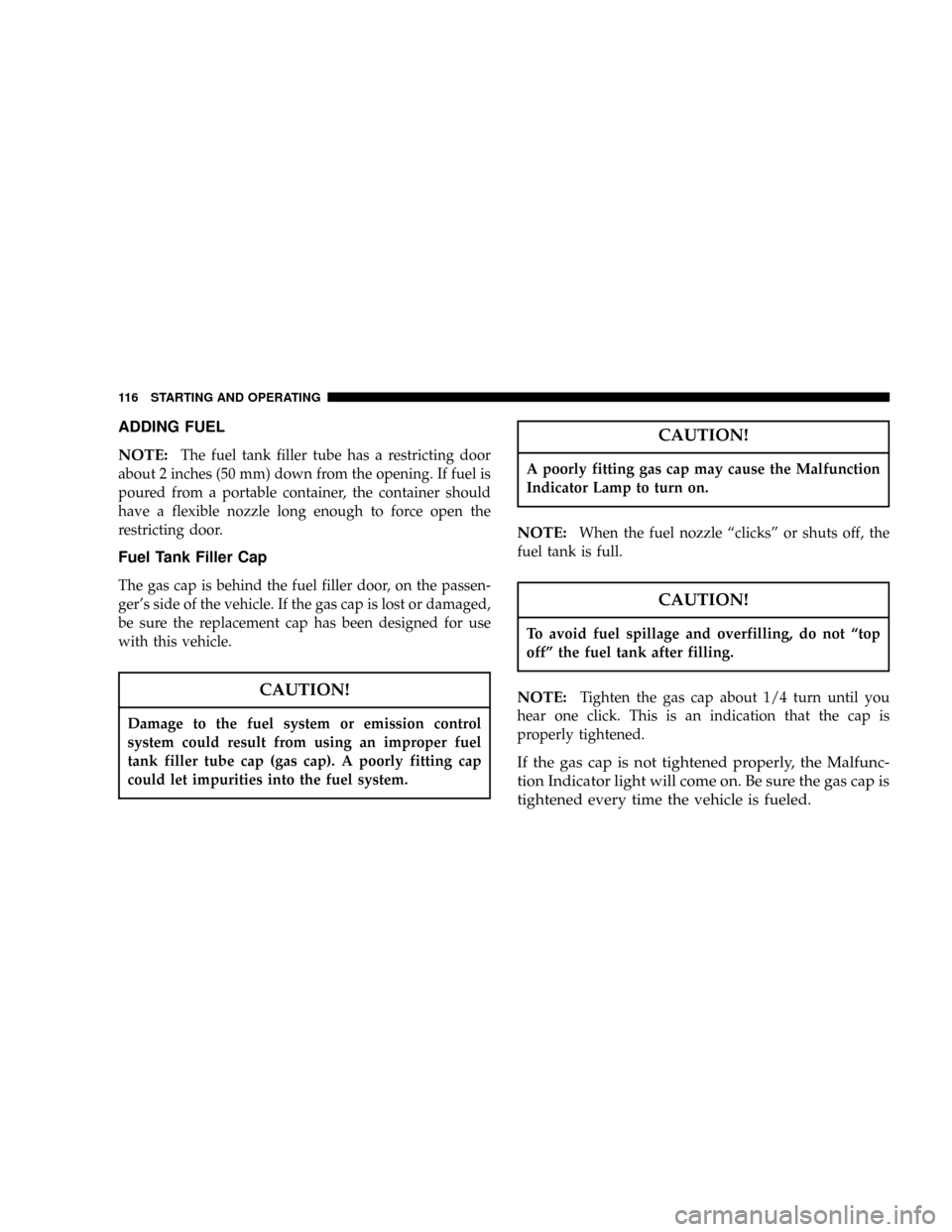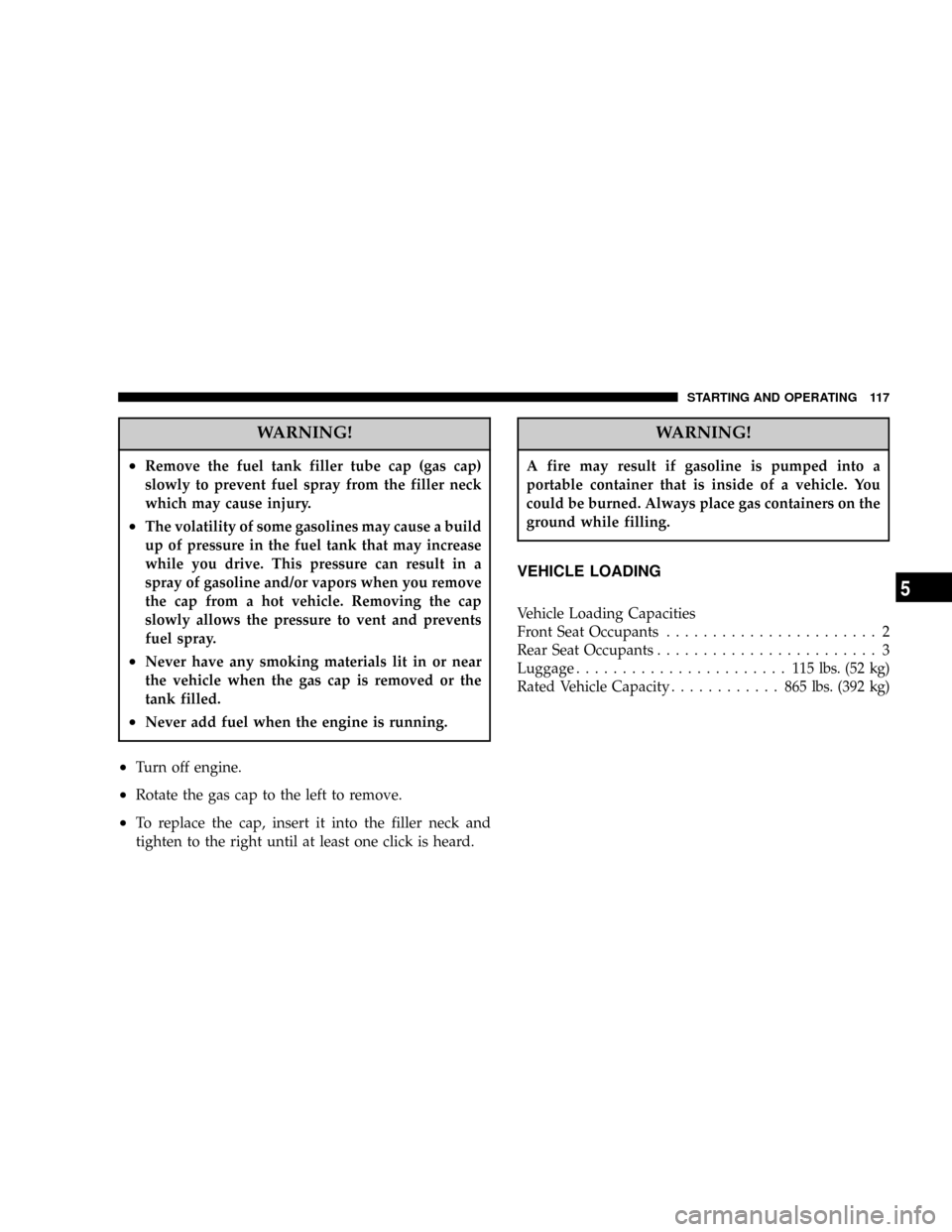2004 DODGE NEON SRT fuel cap
[x] Cancel search: fuel capPage 66 of 200

16. Malfunction Indicator Light
This light is part of an onboard diagnostic
system called OBD that monitors engine con-
trol systems. The light will illuminate briefly
when the key is in the ON/RUN position before
engine start. If the bulb does not come on when
turning the key from OFF to ON/RUN, have the
condition checked promptly.
Certain conditions such as a loose or missing gas cap,
poor fuel quality, etc., may illuminate the light after
engine start. The vehicle should be serviced if the light
stays on through several of your typical driving cycles. In
most situations, the vehicle will drive normally and will
not require towing.
If the Malfunction Indicator Light flashes when the
engine is running, serious conditions may exist that
could lead to immediate loss of power or severe catalytic
converter damage. The vehicle should be serviced as
soon as possible if this occurs.
17. Odometer/Trip Odometer Reset Knob
Press this knob to switch between the odometer and trip
odometer. While the trip odometer is being displayed,
press and hold this knob for a few seconds to reset the
trip odometer to zero miles/kilometers.
18. Odometer/Trip Odometer
Shows the total distance the vehicle has been driven.
U.S. Federal regulations require that upon transfer of
vehicle ownership, the seller certify to the purchaser the
correct mileage that the vehicle has been driven. There-
fore, if the odometer reading changes during repair or
replacement, be sure to keep a record of the reading
before and after the service so the correct mileage can be
determined.
19. Door Ajar Indicator
This vacuum fluorescent indicator illuminates when a
door is not completely closed. If the door is open for more
than 8 minutes and the ignition key is in the OFF
position, the indicator will turn off.
66 UNDERSTANDING YOUR INSTRUMENT PANEL
Page 86 of 200

NTire Inflation Pressures.................105
NRadial-Ply Tires......................107
NCompact Spare Tire....................107
NTire Spinning........................108
NTread Wear Indicators..................109
NReplacement Tires.....................109
NAlignment And Balance.................110
mTire Chains...........................111
mSnow Tires...........................111
mTire Rotation Recommendations...........112
mSelecting Fuel.........................113N2.4L Turbo..........................113
NSpark Knock.........................113
NReformulated Gasoline.................114
NGasoline/Oxygenate Blends..............114
NMMT In Gasoline.....................114
NSulfur In Gasoline.....................115
NMaterials Added To Fuel................115
mAdding Fuel..........................116
NFuel Tank Filler Cap...................116
mVehicle Loading.......................117
86 STARTING AND OPERATING
Page 116 of 200

ADDING FUEL
NOTE:
The fuel tank filler tube has a restricting door
about 2 inches (50 mm) down from the opening. If fuel is
poured from a portable container, the container should
have a flexible nozzle long enough to force open the
restricting door.
Fuel Tank Filler Cap
The gas cap is behind the fuel filler door, on the passen-
ger's side of the vehicle. If the gas cap is lost or damaged,
be sure the replacement cap has been designed for use
with this vehicle.
CAUTION!
Damage to the fuel system or emission control
system could result from using an improper fuel
tank filler tube cap (gas cap). A poorly fitting cap
could let impurities into the fuel system.
CAUTION!
A poorly fitting gas cap may cause the Malfunction
Indicator Lamp to turn on.
NOTE:When the fuel nozzle ªclicksº or shuts off, the
fuel tank is full.
CAUTION!
To avoid fuel spillage and overfilling, do not ªtop
offº the fuel tank after filling.
NOTE:Tighten the gas cap about 1/4 turn until you
hear one click. This is an indication that the cap is
properly tightened.
If the gas cap is not tightened properly, the Malfunc-
tion Indicator light will come on. Be sure the gas cap is
tightened every time the vehicle is fueled.
116 STARTING AND OPERATING
Page 117 of 200

WARNING!
²Remove the fuel tank filler tube cap (gas cap)
slowly to prevent fuel spray from the filler neck
which may cause injury.
²The volatility of some gasolines may cause a build
up of pressure in the fuel tank that may increase
while you drive. This pressure can result in a
spray of gasoline and/or vapors when you remove
the cap from a hot vehicle. Removing the cap
slowly allows the pressure to vent and prevents
fuel spray.
²Never have any smoking materials lit in or near
the vehicle when the gas cap is removed or the
tank filled.
²Never add fuel when the engine is running.
²Turn off engine.
²Rotate the gas cap to the left to remove.
²To replace the cap, insert it into the filler neck and
tighten to the right until at least one click is heard.
WARNING!
A fire may result if gasoline is pumped into a
portable container that is inside of a vehicle. You
could be burned. Always place gas containers on the
ground while filling.
VEHICLE LOADING
Vehicle Loading Capacities
Front Seat Occupants....................... 2
Rear Seat Occupants........................ 3
Luggage....................... 115lbs. (52 kg)
Rated Vehicle Capacity............ 865lbs. (392 kg)
STARTING AND OPERATING 117
5
Page 165 of 200

FLUID CAPACITIES
U.S. Metric
Fuel (Approximate)12.5 Gallons 47.5 Liters
Engine Oil
2.4 Liter Turbo Charged Engines 5.0 qts 4.8 Liters
Cooling System *
2.4 Liter Turbo Charged Engines 8.1 qts 7.7 Liters
* Includes heater and coolant recovery bottle filled to MAX level.
MAINTAINING YOUR VEHICLE 165
7
Page 192 of 200

ABS (Anti-Lock Brake) System.............. 94
Adding Engine Coolant (Antifreeze)......... 150
Adding Fuel........................... 116
Air Cleaner, Engine..................... 142
Air Conditioning.....................78,144
Air Conditioning Controls................. 78
Air Conditioning Refrigerant.............. 144
Air Conditioning System................. 144
Air Pressure, Tires...................... 105
Airbag................................ 27
Airbag Deployment...................... 33
Airbag Light.......................35,44,65
Airbag Maintenance...................... 35
Airbag, Side........................... 34
Alarm, Panic........................... 17
Alarm System.......................... 65
Alignment and Balance.................. 110
Alterations/Modifications, Vehicle............ 6
Antenna, Satellite Radio................... 76
Antifreeze (Engine Coolant)............165,166
Anti-Lock Brake System................... 94
Anti-Lock Warning Light.................. 63
Appearance Care....................... 155Ashtrays and Lighter..................... 58
Automatic Door Locks.................... 13
Ball Joints............................ 145
Battery............................... 142
Keyless Transmitter Replacement.......... 18
Belts, Drive........................... 140
Belts, Engine.......................... 142
Body Mechanism Lubrication.............. 145
B-Pillar Location....................... 100
Brake Fluid........................... 166
Brake, Parking.......................... 92
Brake System........................94,153
Anti-Lock............................ 94
Hoses.............................. 153
Master Cylinder...................... 154
Parking............................. 92
Warning Light........................ 63
Break-In Recommendations, New Vehicle...... 42
Bulb Replacement...................162,163
Caps, Filler
Fuel............................... 116
192 INDEX
Page 194 of 200

Downshifting........................... 92
Drive Belts............................ 140
Driving
On Slippery Surfaces.................. 128
Electric Remote Mirrors................... 48
Emergency, In Case of
Jacking............................. 122
Jump Starting........................ 125
Towing............................. 130
Emergency Trunk Release................. 15
Emission Control System Maintenance....... 168
Engine
Break-In Recommendations............... 42
Checking Oil Level.................... 137
Jump Starting........................ 125
Oil ..........................137,165,166
Oil Change Interval................... 138
Oil Filter............................ 166
Oil Selection......................... 138
Oil Synthetic......................... 139
Overheating......................... 120
Temperature Gauge.................... 67Timing Belt.......................... 142
Exhaust Gas Caution..................... 43
Exhaust System........................ 147
Filters
Air Cleaner.......................... 142
Engine Fuel......................... 142
Engine Oil.......................140,166
Flooded Engine Starting................... 88
Fluid, Brake........................... 166
Fluid Capacities........................ 165
Fluid Leaks............................ 44
Fluid Level Checks
Manual Transaxle..................... 155
Fog Lights...........................54,63
Freeing A Stuck Vehicle.................. 129
Fuel.............................. 113,166
Adding............................. 116
Filler Cap........................... 116
Filter.............................. 142
Gauge.............................. 65
Light............................... 65
Octane Rating........................ 113
194 INDEX
Page 195 of 200

Fuses................................ 160
GasCap .............................. 116
Gasoline............................. 165
Gasoline, Reformulated.................. 114
Gasoline/Oxygenate Blends............... 114
Gauges
Coolant Temperature................... 67
Fuel................................ 65
Tachometer.......................... 64
Turbo Boost.......................83,113
General Information...................... 11
Glass Cleaning......................... 159
Hazard Warning Flasher.................. 120
Headlights............................. 54
Bulb Replacement..................... 163
Cleaning............................ 159
High Beam........................... 64
Switch.............................. 54
Hood Prop............................ 52
Hood Release.......................... 51
Hoses............................... 152Ignition
Key ................................. 9
Wiring System....................... 142
Immobilizer............................. 9
Infant Restraint......................... 36
Inside Rearview Mirror................... 47
Instrument Cluster.....................62,63
Instrument Panel and Controls.............. 61
Instrument Panel Cover.................. 159
Instrument Panel Lens Cleaning............ 159
Interior Appearance Care................. 158
Interior Fuses.......................... 161
Interior Lights.......................... 53
Intermittent Wipers...................... 56
Introduction............................ 4
Jack Operation......................... 122
Jump Starting......................... 125
Key, Programming....................... 11
Key, Replacement....................... 10
Key, Sentry............................. 9
Key-In Reminder......................... 9
INDEX 195
10